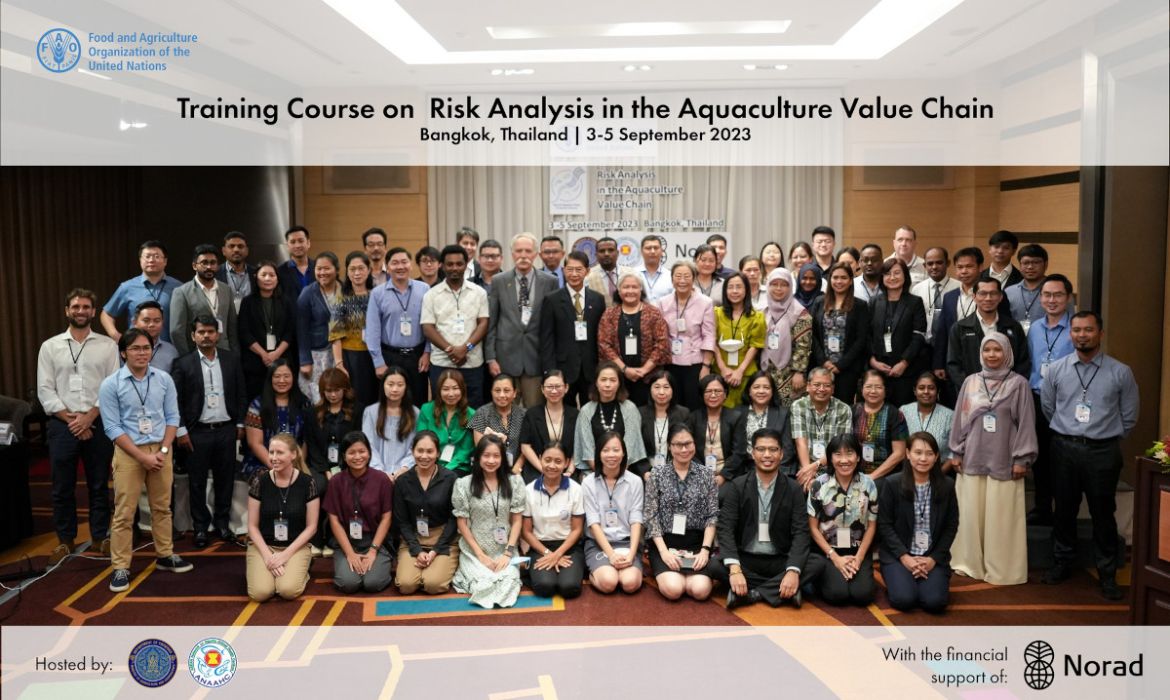Training course on Risk Analysis in the Aquaculture Value Chain held in Bangkok
5 September 2023 | 868 views | .pdf | 3.86 MB | Health and welfare, Australia, Cambodia, China, India, Indonesia, Lao PDR, Malaysia, Philippines, Sri Lanka, Thailand, Vietnam, Myanmar, Saudi Arabia

FAO organised a training course on Risk Analysis in the Value Chain, under the project GCP/GLO/352/NOR from 3-5 September in Bangkok, Thailand, in collaboration with the Department of Fisheries (DoF) and the ASEAN Network of Aquatic Animal Health Centres led by the Thai DoF, and NACA and INFOFISH. The organisers wish to gratefully acknowledge the financial support provided by the Norwegian Agency for Development Cooperation (Norad) and the Thailand DoF.
The development of a national aquatic organism health strategy is a key component of safeguarding a country’s aquaculture industry and biodiversity. It also plays a key role in securing international trade in aquatic products and in maintaining market access.
Risk analysis is an essential component of a national aquatic organism health strategy. Now widely applied in many fields, risk analysis provides a science-based framework for evaluating hazards, determining the likelihood and extent of potential harms, mitigating risks and guiding policy decisions.
Value chain analysis is a detailed study of the processes throughout the value chain, including production, marketing, processing, retailers, and consumers. This includes understanding aquaculture production systems and how stakeholders operate and the decisions they make.
Combining risk and value chain analysis provides a risk-based and people-centred approach to managing disease risks and planning control measures for aquaculture systems.
The course aimed to build capacity in conducting risk analysis to support the development of national aquatic organism health strategies, as a first step in the implementation of the four-stage Progressive Management Pathway for Aquaculture Biosecurity initiative of FAO.
The course included training on:
- Disease emergence in aquaculture.
- Risk-based approaches to progressive management pathways to aquaculture biosecurity.
- National aquatic organism health strategies.
- Health management and biosecurity.
- Import risk analysis.
- Value chain analysis.
- Transmission pathways.
- Biosecurity vulnerabilities, risk hotspots and risk factors.
- How to create risk pathways, assign likelihoods and use matrices.
- Movement of aquatic organisms in ASEAN.
Participants conducted a desktop value chain risk analysis exercise for selected aquatic commodities involving value chain risk analysis, hazard identification, identification of risk factors and biosecurity vulnerabilities, and a risk assessment proper. Participants also completed five elearning lessons from the FAO elearning Academy on Pathway to aquaculture biosecurity: managing risks in the value chain and received a digital badge.
The course was attended by some 70 participants from 16 countries from south and southeast Asia, Australia, China, Ethiopia and Saudi Arabia, representing government, private sector and academia. It was taught by Dr Richard Arthur (Canada), Dr Yuko Hood (Australian Department of Agriculture, Fisheries and Forestry), Dr Brett Mackinnon (City University of Hong Kong), Dr Melba Reantaso (FAO) and Dr Saraya Tavornpanich (Norwegian Veterinary Institute).
The manual for the course is available for download from the link below.
Creative Commons Attribution.